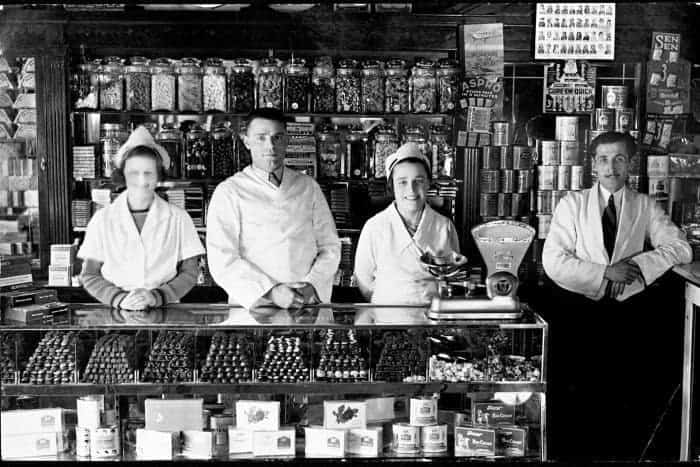Katoomba’s iconic Paragon Café is a fitting place for GCT’s Anna Cominos to share a Devonshire tea with photographer Effy Alexakis and historian Leonard Janiszewski, as they talk about their new book Greek Cafés and Milk Bars of Australia.
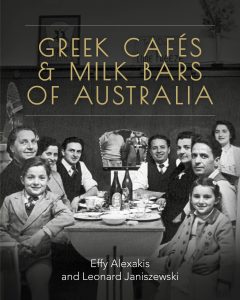
The seeds of modern-day multicultural Australia spring from the interactions of Anglo-Australians with the Greek families that operated the Greek Cafes, argues historian Leonard Janiszweski. After years of researching the network of Greek cafes that sprung up in every Australian country town, Leonard and Effy Alexakis are now busy promoting their just-published book, Greek Cafes & Milk-Bars of Australia.
“Thirty-five years ago, while travelling around rural Australia, we had the impulse to create a book that recorded the rise of the Greek culture in Australia through the Greek Café culture”, clarifies Leonard. Effy and Leonard have criss-crossed Australia, travelling to many isolated towns, collecting photos and the people’s stories and tenderly compiled them into Greek Cafes & Milk-Bars of Australia. The enormity of the book and Effy and Leonard’s deep desire to tell the Greek Café stories with integrity meant they became waylaid by side-projects, including the Greek Café Photographic Exhibition on tour around Australia since 2008 to this day.
“Many Greek families we met were keen to show us pictures of the Café life. The people who populated it, family celebrations, proud proprietors,” says Effy and she began to collect these images, carefully reproducing many of them in this book.“It’s like a visual essay, Leonard’s historical writing that accompanies the photos gives them a context,” explains Effy.
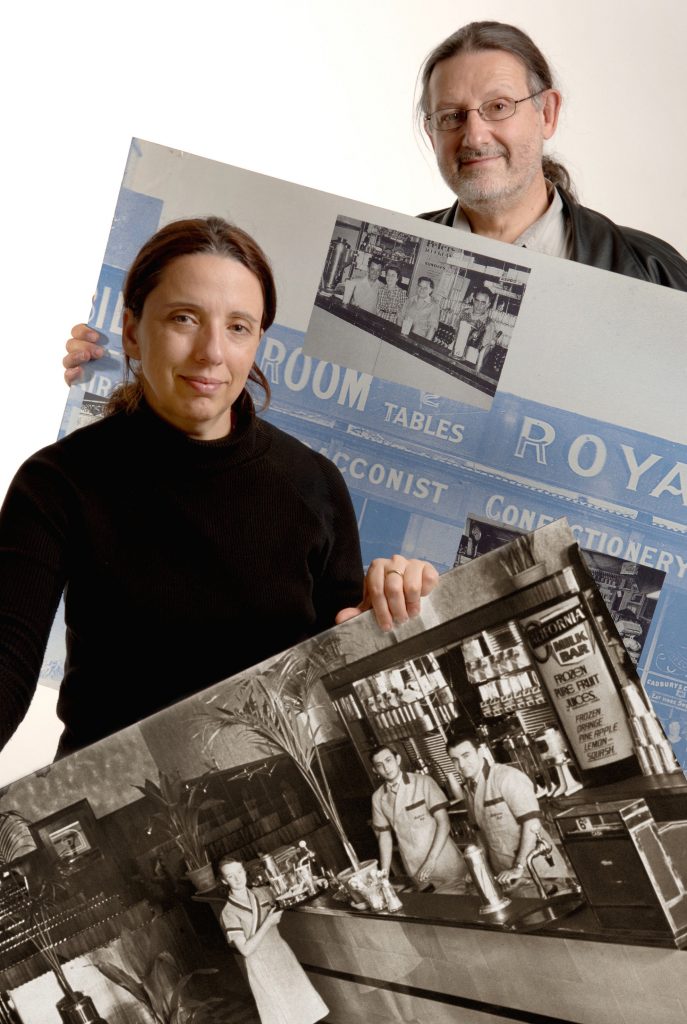
“Through imagery the book tracks the rise of multicultural Australia and makes corrections in contemporary Australian history. It was in the exploration of where the newly arrived Greeks got the Cafes’ resources and ideas from, that we discovered there was a lively exchange of ideas in the Greek diaspora, particularly new innovations coming from the
American based Greek community”, reveals Leonard.
Greek Cafes & Milk-Bars of Australia has many historical images of early Oyster Saloons, the precursor to Greek cafes. They were originally a British working-class institution. The British were very class-oriented in how they ate in public and the egalitarian idea of Oyster bars also took off in Australia. So initially newly established Greeks, set-up and worked in Oyster bars. Having proved very popular, the Oyster bars began to expand their services by offering meals, sweet candy and of course sodas, therefore Australia witnessed the end of socially stratified eating.
Established Oyster Bars began to extend their services to all society, so the Oyster Bars morphed into the Greek Cafes. These elaborate cafes were a revolutionary economic base offering in-house dining to all and sweets proved very popular; such as wrapping their own chocolate bars (there was no commercial production of chocolate at this time) and making their own in-house ice creams. Later many cafés took the name of popular ice-cream makers to send a message that those ice-creams were available.
The book features many photos of milk bars; milkshakes had actually come from the American drug store culture and quickly became the staple of new milk bars. Fantastic organic syrups were used to flavour the milkshake, remember that milkshakes originally were created to assist people to take their medicines. Mick Adams’ striking Black and White milk bars sprung up all over Australia and were a hit in such places as Sydney’s Martin Place.
Greek Cafes and Milk Bars of Australia, is full of images of the incredible Café facades and the shop proprietors standing proudly in front of them.
“This enterprising exchange of ideas over continents could not be more obvious than in the architecture and shop designs of the Greek Café and Milk Bars, which were immaculate and drew on the fantasy created by American Cinema. Shopfitters such as Stephen C Varvaressos, understood what his clients wanted and was very precise in his Café designs, giving the customers a unique and unforgettable experience,” says Leonard.
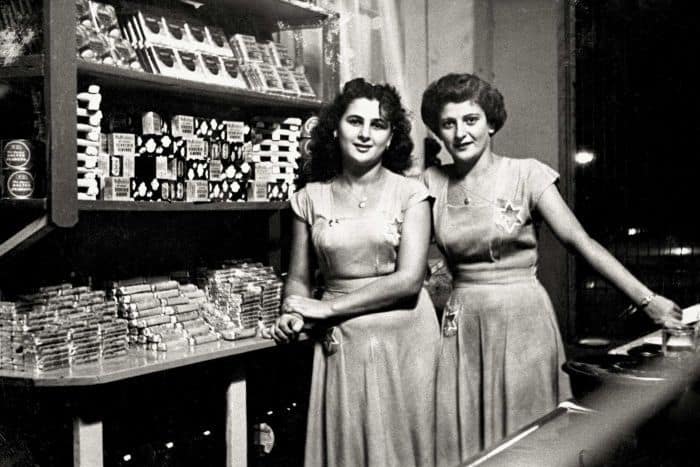
“Varvaressos took this vision to new heights using Streamline Moderne and Curvel Linear as his design signature. It appears everything was considered even the Soda fountains were amazingly lit. Actually, that is where the term the Light fantastic comes from,” he adds.
While patriarchal in its vision, Greek women also played a direct role in the success of Greek Cafes, as many of the images show. Apart from having a variety of duties in the cafe, they also had added responsibility of raising their family with the values of the homeland. They instructed children in cultural and religious rituals and ethics. Greek Cafes and Milk Bars of Australia challenges the nuances and misconceptions about Australia.
It’s a monumental book with incredible archival images researched and saved by Effy Alexakis and a fascinating historical narrative told by Leonard Janiszewski that re-interprets contemporary Australian culture without rose-coloured glasses.
Much of the Greek settlement in Australia during the 20th century can be traced to the emergence of Greek cafes. It appears that every Australian country town featured a Greek café at some time. Katoomba’s iconic Paragon Café is the treasure in this roadmap of Greek settlement and one of the few remaining working cafés in Australia. Originally created and operated by Zacharia Simos in 1916, he later married Mary Simos and along with their extended family operated the Paragon Café well in to the 1990s. Today the Paragon Café is in dire need of restoration to the building to save the original features.
PARAGON CAFE
As you enter the Paragon Café you make way onto the exquisite wooden shopfront from where Paragon’s famous handmade chocolates are displayed. Classical depictions of ancient Greek figures adorn the sitting booths, which invites guests to escape the chill and warm themselves on fresh delicacies.
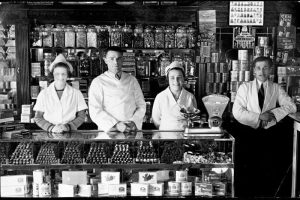
The Paragon Café also has two beautifully crafted venues internally; the mirrored Blue Room is now a cabaret venue and the wood-panelled Banquet Room is a fantastic place to hold a private lunch or dinner function.
Once an amazing hub of homemade ice-creams, breads and sweets as well as the famous Paragon Chocolates, the Paragon Café is a must see for all. As historian Leonard Janiszewski recently publicly stated here, “How would you feel if the Paragon Café disappeared next year, because it’s a real possibility!”
To learn more and assist in saving this national treasure, contact the Friends of the Paragon Inc or visit theparagonhistory.com.au

